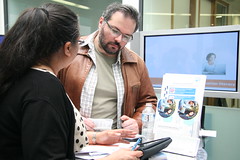I began the year with a couple of goals that I thought I needed to work on to help increase both my business and my web presence.
 |
What I realized is that, even though I’ve been online for a whole lot of years, which includes hitting 10 years on my business blog and 7 years on this blog, overall I’m still an unknown entity. I’m not sure if it’s because my name, Mitch Mitchell, is the same as Jimi Hendrix’ drummer’s name, or whether my writing style isn’t enough to capture enough people’s attention, or maybe all those times that I’ve been out of town and haven’t commented on as many blogs as I used to in the past, has stripped me of any name recognition.
Either that or people just don’t like me anymore. 🙂
In any case, I knew that I had to find ways to get noticed a lot more than I’ve been noticed lately. So I decided to start what I felt like was a more aggressive online strategy of promotion. This post is going to talk about things I’ve done and how they’ve worked out.
Let’s start with Twitter. I’m pretty active on Twitter already, reading a lot of people’s links, commenting on those links, sharing those links, and often finding people to talk to, though pretty late at night. What I realized is that I didn’t share my own stuff enough. So what I started doing is posting links from this blog on Twitter at least five times a day. The way I was doing it initially was kind of problematic, because most of the links I posted were at night instead of during the daytime when there was a possibility that more people would see them.
I did that for about a month and took a look at my analytics and saw that Twitter was now the number two referrer to the blog. However, I didn’t really notice all that much of a difference in traffic to the blog. Still, I’ll take what I can get.
Then I watched a video by a young lady named Amy who has the channel she calls Savvy Sexy Social. She offers all types of marketing tips, especially online, and in this particular video ( I can’t remember which one now) she talked about scheduling tweets during the day. I had never thought about doing this before, but she mentioned that Tweetdeck allowed you to schedule tweets and showed how it works.
I thought that was pretty neat, so I decided to employ that as a strategy. Over the last 10 days I’ve been scheduling tweets to basically run throughout the day, in general covering the period between 9AM and midnight. I figured that anything else I post between the other period I would post live, since I tend to stay up late. I set up my tweets to go live between every 25 to 35 minutes throughout the day, with one exception I’ll mention later.
 |
I also decided that I had to add some other things to the mix. So, I added links to my business blog, some links from a couple of other blogs, and actual quotations that I have made on my business blog over the years. It turns out that every one of us is actually quotable based on things we’ve written, and if we go back and look at that stuff we will find quotes that are pretty good.
I decided to start with my oldest blog posts and work forward, and at this point I’m through June 2008, so I have another 6 1/2 years worth of posts to look at. Whenever I post a quote I’ll pop it in within 13 to 17 minutes of the previous blog link, then I can post my next blog link a bit earlier, though sometimes I just start the period at another 30 minutes. Every once in a while I also add a video link.
In just 10 days the traffic to this blog has increased about 15%. I’m thinking that’s pretty good. My Alexa rank (which some people put down, but it’s not a bad thing to look at as a higher level thing) has gone from 378,000 to 308,000 in that period of time; nope, not mad at all. The traffic to my business blog has also increased, but that’s where things get slightly more complicated and I will tell you why.
Around the beginning of the month our buddy Beverly Mahone happened to mention to me that I should think about writing some articles on LinkedIn. At first I was hesitant but then decided what could it hurt. Instead of writing a brand new article, I took an article off my business blog that I had also used on my consultants group blog, made some modifications and put it up. I was amazed at the response it got. People I didn’t know saw it and liked it, a few people shared it to Twitter, some people commented on it, and some of those people started noticing that my business blog links showed up in my profile and they started reading them there and commenting there on them.
I figured that was pretty amazing, so I started writing more articles on that site. To date I’m up to 10 articles, including one I wrote last Friday. That has resulted in about 50 new people wanting to connect with me on LinkedIn, and I’ve had conversations with three people on the phone. It hasn’t generated any real business, but anytime you can make business connections on the phone and you didn’t have to reach out to someone first, it’s always a good thing. So I thank Bev for that recommendation, and I would recommend LinkedIn in a heartbeat.
The other couple of sites I’m on?
Facebook turns out to be a disaster. It seems that they have determined that fewer than 10 people should be allowed to see anything I put on my business page there, even though I have close to 360 people that have subscribed. A couple of times I resorted to putting my link in other groups and on my personal page, where I saw that it got a couple more views generally, but Facebook is a different animal because the way it counts views doesn’t necessarily mean that someone clicked on it. Thus, I have shown no increase in traffic from Facebook, and am very disappointed in it.
Google Plus? Before I came home I was spending a lot of time on Google Plus, mainly sharing things other people put up and occasionally posting something I did. Whenever I do a video it automatically pops up there, but that doesn’t mean it gets all that many views. Those also don’t drive traffic to any of my sites, but possibly to YouTube, and when I checked those analytics I’m not seeing all that much happening either.
So, it means I have to recommend that if you’re going to put out things that you want people to see you should probably be using either Twitter or LinkedIn. Oh yeah, I should quickly mention that I have stepped up my blog commenting again, and as you know I always say that tends to help drive more traffic to your blog or website.
As I wrote last year, if you’re willing to put in the work you can get more traffic and get more people to know you. I figure this is only the beginning for me in some ways, but I’m willing to put in the work.
What about you?



